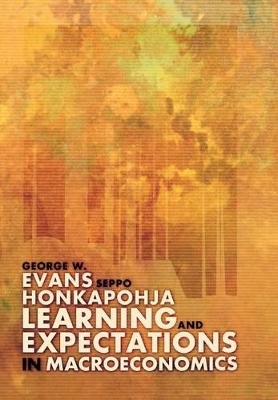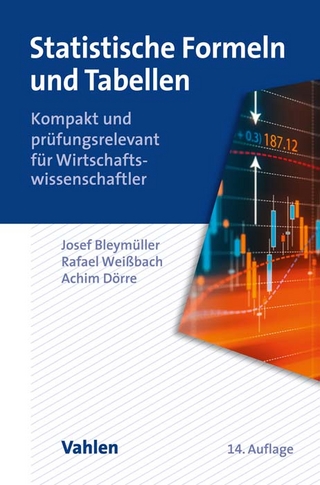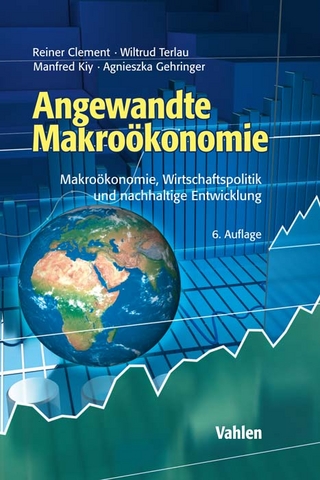
Learning and Expectations in Macroeconomics
Princeton University Press (Verlag)
978-0-691-04921-2 (ISBN)
A crucial challenge for economists is figuring out how people interpret the world and form expectations that will likely influence their economic activity. Inflation, asset prices, exchange rates, investment, and consumption are just some of the economic variables that are largely explained by expectations. Here George Evans and Seppo Honkapohja bring new explanatory power to a variety of expectation formation models by focusing on the learning factor. Whereas the rational expectations paradigm offers the prevailing method to determining expectations, it assumes very theoretical knowledge on the part of economic actors. Evans and Honkapohja contribute to a growing body of research positing that households and firms learn by making forecasts using observed data, updating their forecast rules over time in response to errors. This book is the first systematic development of the new statistical learning approach. Depending on the particular economic structure, the economy may converge to a standard rational-expectations or a "rational bubble" solution, or exhibit persistent learning dynamics.
The learning approach also provides tools to assess the importance of new models with expectational indeterminacy, in which expectations are an independent cause of macroeconomic fluctuations. Moreover, learning dynamics provide a theory for the evolution of expectations and selection between alternative equilibria, with implications for business cycles, asset price volatility, and policy. This book provides an authoritative treatment of this emerging field, developing the analytical techniques in detail and using them to synthesize and extend existing research.
George W. Evans is John B. Hamacher Professor of Economics at the University of Oregon, and has held positions at the London School of Economics, Stanford University, and the University of Edinburgh. Seppo Honkapohja is Professor of Economics at the University of Helsinki, where he has currently been appointed Academy Professor. Professors Evans and Honkapohja have published extensively in economic journals, and each is best known for his respective research on expectations and learning in dynamic models. This book is the outgrowth of over fifteen years of collaboration between them.
Preface xv Part I. View of the Landscape 1 Expectations and the Learning Approach 5 1.1 Expectations in Macroeconomics 5 1.2 Two Examples 8 1.3 Classical Models of Expectation Formation 9 1.4 Learning: The New View of Expectations 12 1.5 Statistical Approach to Learning 15 1.6 A General Framework 16 1.7 Overview of the Book 19 2 Introduction to the Techniques 25 2.1 Introduction 25 2.2 The Cobweb Model 26 2.3 Econometric Learning 27 2.4 Expectational Stability 30 2.5 Rational vs. Reasonable Learning 32 2.6 Recursive Least Squares 32 2.7 Convergence of Stochastic Recursive Algorithms 34 2.8 Application to the Cobweb Model 37 2.9 The E-Stability Principle 39 2.10 Discussion of the Literature 43 3 Variations on a Theme 45 3.1 Introduction 45 3.2 Heterogeneous Expectations 45 3.3 Learning with Constant Gain 48 3.4 Learning in Nonstochastic Models 50 3.5 Stochastic Gradient Learning 55 3.6 Learning with Misspecification 56 4 Applications 59 4.1 Introduction 59 4.2 The Overlapping Generations Model 60 4.3 A Linear Stochastic Macroeconomic Model 63 4.4 The Ramsey Model 68 4.5 The Diamond Growth Model 71 4.6 A Model with Increasing Social Returns 72 4.7 Other Models 81 4.8 Appendix 82 Part II. Mathematical Background and Tools 5 The Mathematical Background 87 5.1 Introduction 87 5.2 Difference Equations 88 5.3 Differential Equations 93 5.4 Linear Stochastic Processes 99 5.5 Markov Processes 108 5.6 Ito Processes 110 5.7 Appendix on Matrix Algebra 115 5.8 References for Mathematical Background 118 6 Tools: Stochastic Approximation 121 6.1 Introduction 121 6.2 Stochastic Recursive Algorithms 123 6.3 Convergence: The Basic Results 128 6.4 Convergence: Further Discussion 134 6.5 Instability Results 138 6.6 Expectational Stability 140 6.7 Global Convergence 144 7 Further Topics in Stochastic Approximation 147 7.1 Introduction 147 7.2 Algorithms for Nonstochastic Frameworks 148 7.3 The Case of Markovian State Dynamics 154 7.4 Convergence Results for Constant-Gain Algorithms 162 7.5 Gaussian Approximation for Cases of Decreasing Gain 166 7.6 Global Convergence on Compact Domains 167 7.7 Guide to the Technical Literature 169 Part III. Learning in Linear Models 8 Univariate Linear Models 173 8.1 Introduction 173 8.2 A Special Case 174 8.3 E-Stability and Least Squares Learning: MSV Solutions 179 8.4 E-Stability and Learning: The Full Class of Solutions 183 8.5 Extension 1: Lagged Endogenous Variables 193 8.6 Extension 2: Models with Time-t Dating 198 8.7 Conclusions 204 9 Further Topics in Linear Models 205 9.1 Introduction 205 9.2 Muth's Inventory Model 205 9.3 Overparameterization in the Special Case 206 9.4 Extended Special Case 211 9.5 Linear Model with Two Forward Leads 215 9.6 Learning Explosive Solutions 219 9.7 Bubbles in Asset Prices 220 9.8 Heterogeneous Learning Rules 223 10 Multivariate Linear Models 227 10.1 Introduction 227 10.2 MSV Solutions and Learning 229 10.3 Models with Contemporaneous Expectations 236 10.4 Real Business Cycle Model 239 10.5 Irregular REE 243 10.6 Conclusions 249 10.7 Appendix 1: Linearizations 249 10.8 Appendix 2: Solution Techniques 252 Part IV Learning in Nonlinear Models Nonlinear Models: Steady States 267 11.1 Introduction 267 11.2 Equilibria under Perfect Foresight 269 11.3 Noisy Steady States 269 11.4 Adaptive Learning for Steady States 273 11.5 E-Stability and Learning 273 11.6 Applications 276 12 Cycles and Sunspot Equilibria 287 12.1 Introduction 287 12.2 Overview of Results 288 12.3 Deterministic Cycles 291 12.4 Noisy Cycles 293 12.5 Existence of Sunspot Equilibria 300 12.6 Learning SSEs 304 12.7 Global Analysis of Learning Dynamics 310 12.8 Conclusions 313 Part V. Further Topics 13 Misspecification and Learning 317 13.1 Learning in Misspecified Models 317 13.2 Misspecified Policy Learning 325 13.3 Conclusions 329 14 Persistent Learning Dynamics 331 14.1 Introduction 331 14.2 Constant-Gain Learning in the Cobweb Model 333 14.3 Increasing Social Returns and Endogenous Fluctuations 337 14.4 Sargent's Inflation Model 348 14.5 Other Models with Persistent Dynamics 356 14.6 Conclusions 359 15 Extensions and Other Approaches 361 15.1 Models from Computational Intelligence 361 15.2 Alternative Gain Sequences 370 15.3 Nonparametric Learning 372 15.4 Eductive Learning 372 15.5 Calculation Equilibria 376 15.6 Adaptively Rational Expectations Equilibria 378 15.7 Experimental Work 380 15.8 Some Empirical Applications 382 16 Conclusions 385 Bibliography 389 Author Index 407 Subject Index 411
| Erscheint lt. Verlag | 28.1.2001 |
|---|---|
| Reihe/Serie | Frontiers of Economic Research |
| Verlagsort | New Jersey |
| Sprache | englisch |
| Maße | 152 x 235 mm |
| Gewicht | 765 g |
| Themenwelt | Wirtschaft ► Allgemeines / Lexika |
| Wirtschaft ► Volkswirtschaftslehre ► Makroökonomie | |
| ISBN-10 | 0-691-04921-1 / 0691049211 |
| ISBN-13 | 978-0-691-04921-2 / 9780691049212 |
| Zustand | Neuware |
| Haben Sie eine Frage zum Produkt? |
aus dem Bereich


